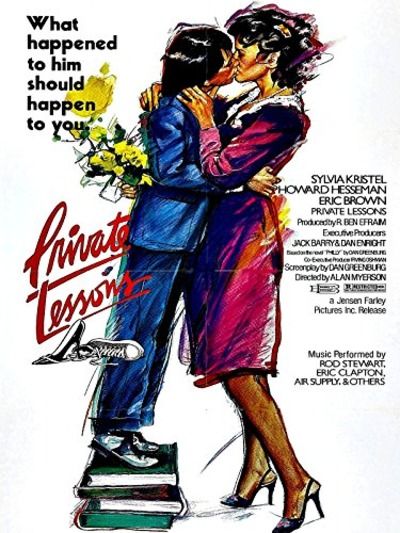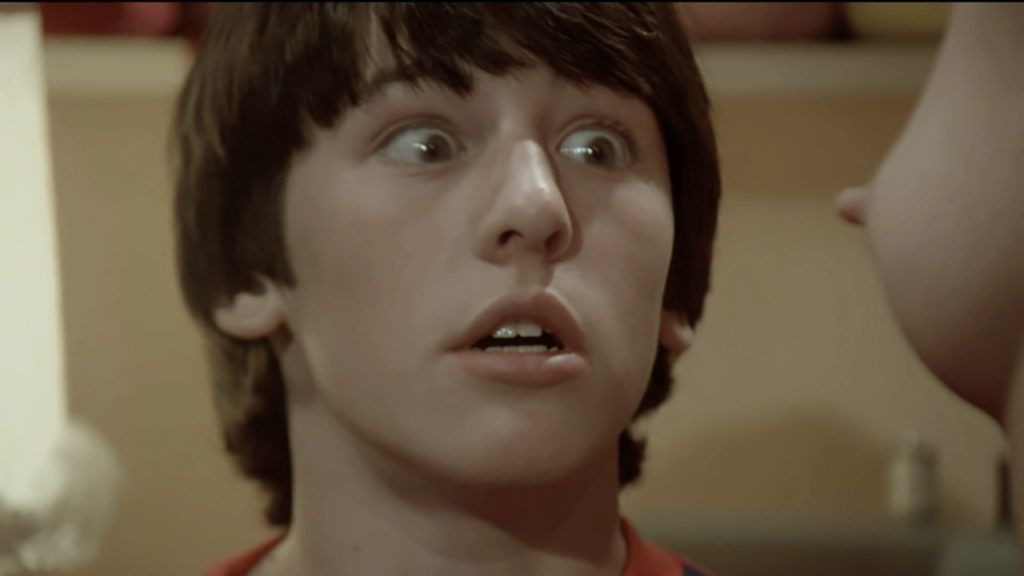
Rating: B-
Dir: Alan Myerson
Star: Eric Brown, Sylvia Kristel, Howard Hesseman, Patrick Piccininni
When they say “They couldn’t make films like _____ these days,” there’s a good case to be made for Private Lessons filling in the blank. Of all the films shot (largely) in Arizona over the decades, there are likely not many which still need to be cut for the delicate sensibilities of British viewers. Indeed, when resubmitted earlier this year, the running-time ended up 15 seconds shorter than when it had previously been submitted in 2006. The problem is, the film largely centres on the relationship between a 15-year-old boy and a much older woman. The BBFC stated, “This work required compulsory cuts to indecent images of children. Cuts were made in accordance with BBFC Guidelines, policy, and the Protection of Children Act 1978.”
To be 100% clear, this isn’t kiddie porn. But the BBFC say, “A shot of a child in the same frame as adults engaged in sexual activity may also be considered to be indecent,” and that leads to the cuts here. A teenage boy in the same shot as a nekkid Sylvia Kristel = between three and four minutes of cuts. For there’s precious little wriggle room: the law does “not allow context or other justifications to be taken into account.” It’s a pity, because this is considerably more thoughtful than most of the teen sex comedies of the decade. If you’re expecting something like Porky’s, you will likely be disappointed. This is not just about seeing tits and losing your virginity – though both certainly happen.
It takes place in the well-to-do Fillmore household, where the father is bringing up his son Philip (Brown) without a mother. “Philly” is at the age where he is intensely curious about the other sex, along with his pal Sherman (Piccininni), and the closest example is housekeeper Nicole Mallow (Kristel). When Dad goes off on a business trip, Philly is delighted to find Nicole not just amenable, but making her own advances to him. However, it turns out this is part of a plot hatched by the house’s chauffeur Lester Lewis (Hesseman). Their aim is to fake Nicole’s death after she has sex with Philly, then blackmail the young boy into opening his father’s safe and handing over ten thousand dollars.
 As you can imagine, it descends into considerably darker territory in tone than most other movies which tick both the “erotic” and “comedy” boxes. It does take a while to get there though. Early on, as the relationship between Philly and Nicole is developing, it’s a breezy romp in which both he and Sherman are thoroughly out of their depth. Most of the humour comes from their wild misconceptions about women and how they work. “Doesn’t that get broads hot, touching their knockers, even with your elbows?” asks Sherman. He then declares, “Nice girls let you touch their knockers if they like you or if they’re going steady with you. If they let you get any farther than that, either they have to be a whore or they’re married to you.”
As you can imagine, it descends into considerably darker territory in tone than most other movies which tick both the “erotic” and “comedy” boxes. It does take a while to get there though. Early on, as the relationship between Philly and Nicole is developing, it’s a breezy romp in which both he and Sherman are thoroughly out of their depth. Most of the humour comes from their wild misconceptions about women and how they work. “Doesn’t that get broads hot, touching their knockers, even with your elbows?” asks Sherman. He then declares, “Nice girls let you touch their knockers if they like you or if they’re going steady with you. If they let you get any farther than that, either they have to be a whore or they’re married to you.”
This helps make for an interesting spectrum of opinions about women. Despite the above, Philly treats Nicole with respect – likely far more than she deserves, given her malicious agenda. She certainly has to try far harder to seduce him, than if fifteen-year-old me had been in his place. Then, as her plot unfolds, it’s Nicole who has second thoughts, and decides to backtrack. She convinces Philly’s tennis teacher (Ed Begley Jr. doing good work) to pretend to be a cop, and scare the bejesus out of Lester. She also realizes there’s no chance of an ongoing relationship with Philly, so leaves. Though the ending does strongly imply he now is imprinted on older women. [Three years later Young, still a teen, would be in They’re Playing With Fire, sleeping with 36-year-old Sybil Danning]
The presence of Kristel clearly signifies to the audience we are through the mirror into wish-fulfillment world, and it should be read as such. Though her star-making role in Emmanuelle was seven years previously, she was still an icon. The contemporary NY Times review called it, “An adolescent’s dream, the kind the Boy Scout manual told you a cold shower would help you forget.” It was certainly far from alone in the genre, though the protagonist here is a couple of years younger than the likes of My Tutor or Risky Business. That, along with the way Philly is more seduced than seducer, probably help explain the controversy around it, and why the words “child rape” crop up in multiple reviews.
Young was initially cast to play Sherman, but original Philly, Neil Barry, was fired 18 days into the 26-day shoot, and all his scenes had to be redone. This was largely filmed in Arizona, due to laxer child labour laws than California, which allowed Young to work more hours per day. But complaints to the police that the production was contributing to the delinquency of a minor, made production relocate to Albuquerque for the sex scenes, despite these being simulated. In related news, my Google search history now includes “New Mexico age of consent.” I am probably on some kind of a watch list. But these scenes are certainly weird, particularly because Young clearly is not Tom Cruise. On the other hand, Kristel drips sex-appeal, and I defy any heterosexual male to honestly say he’d have turned down a bathtime invitation (below) at age 15.
 The original version delivered by Myerson proved problematic for the producers, who felt it was too hot for American audiences, yet not steamy enough for the European one. James Fargo came on board and shot 20 uncredited minutes of new footage, and you can probably tell, especially around the ending which is likely the weakest element. There are also obvious plot holes, such as the supposed “corpse” of Nicole. Or why not just blackmail Philly over the sex, rather than an over-complex fake death? It all definitely seems a lot of trouble for a sum that’s barely thirty grand in current value. Still, the reshoots allowed the film to be hammered into something that would appeal to a teen audience. Appeal it did, reportedly grossing $70 million, on a budget of $2 million.
The original version delivered by Myerson proved problematic for the producers, who felt it was too hot for American audiences, yet not steamy enough for the European one. James Fargo came on board and shot 20 uncredited minutes of new footage, and you can probably tell, especially around the ending which is likely the weakest element. There are also obvious plot holes, such as the supposed “corpse” of Nicole. Or why not just blackmail Philly over the sex, rather than an over-complex fake death? It all definitely seems a lot of trouble for a sum that’s barely thirty grand in current value. Still, the reshoots allowed the film to be hammered into something that would appeal to a teen audience. Appeal it did, reportedly grossing $70 million, on a budget of $2 million.
The soundtrack is deeply embedded in the early eighties. It’s especially heavy on Rod Stewart, who has no less than three songs: Hot Legs, Tonight’s The Night and You’re In My Heart. Other present include John Cougar (before he was Mellencamp), Eric Clapton, Air Supply and the amusingly monickered Randy Van Warmer, whose name is considerably more memorable than his song. In this parade of easy-listening soft rock, which couldn’t be more white if it tried, we suddenly get hit with… Earth, Wind and Fire. I can only presume a song called Fantasy was going to make it onto the soundtrack, regardless of whether the artiste meshed with the others on the roster.
With most of the action taking place in and around the Fillmore mansion, there isn’t a great deal of Arizona atmosphere. I’ve not been able to locate any details of where it is; the DVD commentary is vague on the details, beyond saying it was owned by a conservative family. [Actually, the commentary is vague on most details, except Myerson complaining about his vision being hacked apart. The box-office returns suggest the producers were right] However, there are a couple of scenes at Phoenix Sky Harbor airport, when the father is departing and arriving, and it’s surprising how little the terminal has changed in over forty years. The vehicle chase near the finish also goes along some recognizable streets, ending up with the car going into the Arizona Canal, at the intersection of Indian School Road and 56th Street.
 Some random notes. It was the US debut of director of photography Jan de Bont, who had worked with Paul Verhoeven in their native Holland, and would go on to be the cinematographer on Die Hard. A dozen years later, two sequels would follow, Private Lessons II and Private Lessons: Another Story. The former had a Japanese pop star plus Joanna Pacula, and never received a US release. The latter got four stars from Joe-Bob Briggs, who called it, “One of the best-written, best-photographed, best-directed sexploitationers I’ve seen in years.” Surprisingly, there was a body double used, Judy Helden, for some – but definitely not all – of Kristel’s nude sscenes. You can typically spot the difference because Helden’s nipples are more prominent.
Some random notes. It was the US debut of director of photography Jan de Bont, who had worked with Paul Verhoeven in their native Holland, and would go on to be the cinematographer on Die Hard. A dozen years later, two sequels would follow, Private Lessons II and Private Lessons: Another Story. The former had a Japanese pop star plus Joanna Pacula, and never received a US release. The latter got four stars from Joe-Bob Briggs, who called it, “One of the best-written, best-photographed, best-directed sexploitationers I’ve seen in years.” Surprisingly, there was a body double used, Judy Helden, for some – but definitely not all – of Kristel’s nude sscenes. You can typically spot the difference because Helden’s nipples are more prominent.
Considering what the production went through, from firing its lead, to having to change locations for legal reasons, to major reshoots, it’s amazing the end result still proves so watchable. While its central concept is questionable if you dwell on it, there’s a youthful innocence courtesy of Young’s naive performance, which for me, stops it from becoming creepy. There’s an idealized, almost romantic attitude to sex, in contrast to the messy reality, reminding me of Passion Flower Hotel (which shared cinematographer Richard Suzuki with Emmanuelle, oddly enough). No question, it’s a product of its time. But as someone who was aged fifteen when this came out, it’s a time I look back on with some fondness – despite my teenage years being significantly lacking in mature EuroTotty, compared to Philly’s.
